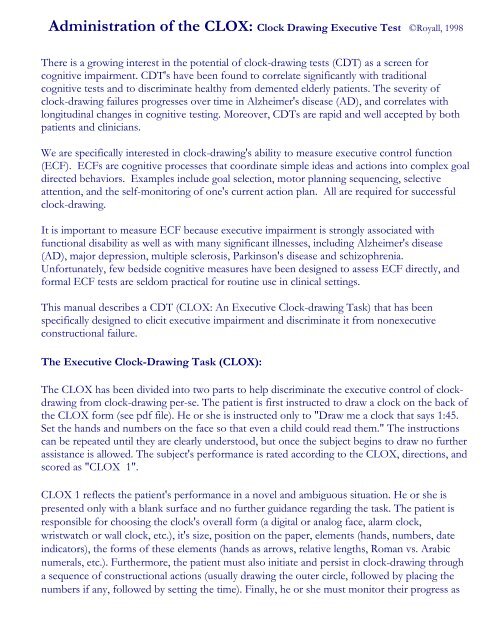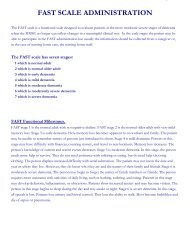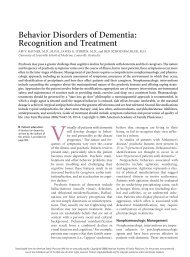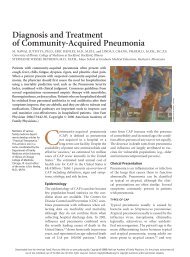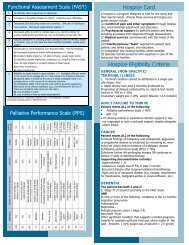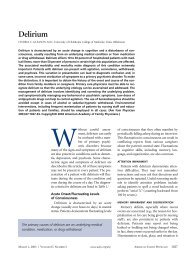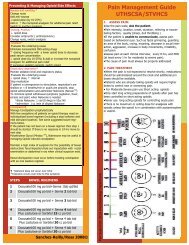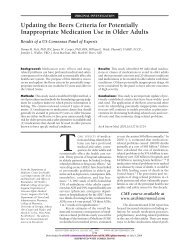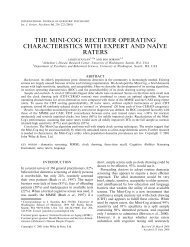Administration of the CLOX: Clock Drawing Executive Test ©Royall ...
Administration of the CLOX: Clock Drawing Executive Test ©Royall ...
Administration of the CLOX: Clock Drawing Executive Test ©Royall ...
Create successful ePaper yourself
Turn your PDF publications into a flip-book with our unique Google optimized e-Paper software.
<strong>Administration</strong> <strong>of</strong> <strong>the</strong> <strong>CLOX</strong>: <strong>Clock</strong> <strong>Drawing</strong> <strong>Executive</strong> <strong>Test</strong> ©Royall, 1998There is a growing interest in <strong>the</strong> potential <strong>of</strong> clock-drawing tests (CDT) as a screen forcognitive impairment. CDT's have been found to correlate significantly with traditionalcognitive tests and to discriminate healthy from demented elderly patients. The severity <strong>of</strong>clock-drawing failures progresses over time in Alzheimer's disease (AD), and correlates withlongitudinal changes in cognitive testing. Moreover, CDTs are rapid and well accepted by bothpatients and clinicians.We are specifically interested in clock-drawing's ability to measure executive control function(ECF). ECFs are cognitive processes that coordinate simple ideas and actions into complex goaldirected behaviors. Examples include goal selection, motor planning sequencing, selectiveattention, and <strong>the</strong> self-monitoring <strong>of</strong> one's current action plan. All are required for successfulclock-drawing.It is important to measure ECF because executive impairment is strongly associated withfunctional disability as well as with many significant illnesses, including Alzheimer's disease(AD), major depression, multiple sclerosis, Parkinson's disease and schizophrenia.Unfortunately, few bedside cognitive measures have been designed to assess ECF directly, andformal ECF tests are seldom practical for routine use in clinical settings.This manual describes a CDT (<strong>CLOX</strong>: An <strong>Executive</strong> <strong>Clock</strong>-drawing Task) that has beenspecifically designed to elicit executive impairment and discriminate it from nonexecutiveconstructional failure.The <strong>Executive</strong> <strong>Clock</strong>-<strong>Drawing</strong> Task (<strong>CLOX</strong>):The <strong>CLOX</strong> has been divided into two parts to help discriminate <strong>the</strong> executive control <strong>of</strong> clockdrawingfrom clock-drawing per-se. The patient is first instructed to draw a clock on <strong>the</strong> back <strong>of</strong><strong>the</strong> <strong>CLOX</strong> form (see pdf file). He or she is instructed only to "Draw me a clock that says 1:45.Set <strong>the</strong> hands and numbers on <strong>the</strong> face so that even a child could read <strong>the</strong>m." The instructionscan be repeated until <strong>the</strong>y are clearly understood, but once <strong>the</strong> subject begins to draw no fur<strong>the</strong>rassistance is allowed. The subject's performance is rated according to <strong>the</strong> <strong>CLOX</strong>, directions, andscored as "<strong>CLOX</strong> 1".<strong>CLOX</strong> 1 reflects <strong>the</strong> patient's performance in a novel and ambiguous situation. He or she ispresented only with a blank surface and no fur<strong>the</strong>r guidance regarding <strong>the</strong> task. The patient isresponsible for choosing <strong>the</strong> clock's overall form (a digital or analog face, alarm clock,wristwatch or wall clock, etc.), it's size, position on <strong>the</strong> paper, elements (hands, numbers, dateindicators), <strong>the</strong> forms <strong>of</strong> <strong>the</strong>se elements (hands as arrows, relative lengths, Roman vs. Arabicnumerals, etc.). Fur<strong>the</strong>rmore, <strong>the</strong> patient must also initiate and persist in clock-drawing througha sequence <strong>of</strong> constructional actions (usually drawing <strong>the</strong> outer circle, followed by placing <strong>the</strong>numbers if any, followed by setting <strong>the</strong> time). Finally, he or she must monitor <strong>the</strong>ir progress as
<strong>the</strong> task unfolds, both anticipating (placing <strong>the</strong> 12, 6, 3, and 9 first) and/or correcting errors as<strong>the</strong>y occur.It is just as important to note what a patient does not do during a clock-drawing task. Our <strong>CLOX</strong>form and its verbal instructions have been designed to tempt <strong>the</strong> patient into, stronglyassociated but irrelevant behaviors. The circle in <strong>the</strong> left lower corner is irrelevant to clockdrawingwhen viewed from <strong>the</strong> back side <strong>of</strong> <strong>the</strong> form, but it tempts <strong>the</strong> patient to place <strong>the</strong>irclock within its image. We chose <strong>the</strong> words "hand" and "face because <strong>the</strong>y are more stronglyassociated with body parts than clock elements, and may trigger semantic intrusions from <strong>the</strong>irmore common meanings. The number " 4'5 " does not appear on a typical clock face, and mayintrude into <strong>the</strong> patient's construction in <strong>the</strong> form <strong>of</strong> a digital image (1:45) or hands pointing to<strong>the</strong> 4 or 5 o' clock positions. Of <strong>the</strong> 15 available <strong>CLOX</strong> points, 13 rate <strong>the</strong> presence <strong>of</strong> subjectchosen elements. Three points reflect <strong>the</strong> inhibition <strong>of</strong> irrelevant distractions, <strong>the</strong> anticipation<strong>of</strong> potential spacing errors, and <strong>the</strong>ir monitoring or correction. <strong>CLOX</strong> scores range from 0-15.Lower scores. reflect greater impairment.The <strong>CLOX</strong>'s second step is a simple copying task. The examiner allows <strong>the</strong> patient to observehim or her drawing a clock in <strong>the</strong> circle provided on <strong>the</strong> scoring sheet. The examiner sets <strong>the</strong>hands again to "1:45", places <strong>the</strong> 12,6,3, and 9 first, and makes <strong>the</strong> hands into arrows. Thepatient is allowed to copy <strong>the</strong> examiner's clock. Score this clock as "<strong>CLOX</strong> 2".


